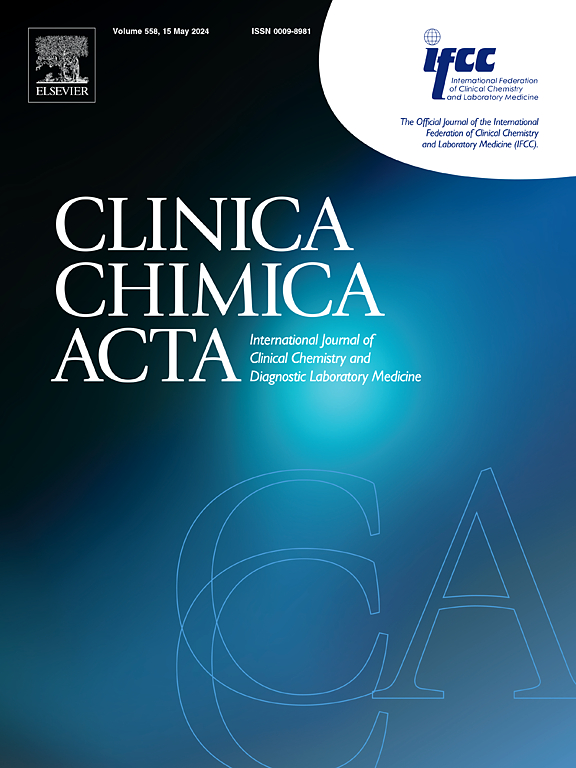CSF biomarkers in leak detection: A systematic review & meta-analysis of diagnostic test accuracy (DTA) studies
IF 3.2
3区 医学
Q2 MEDICAL LABORATORY TECHNOLOGY
引用次数: 0
Abstract
Background
Cerebrospinal fluid (CSF) leaks result from dural tears due to traumatic and non-traumatic causes, potentially leading to meningitis, intracranial infections, subdural hematomas, and even death. Neuroimaging is still the standard diagnostic tool but presents economic and logistical challenges. Non-invasive biochemical methods offer valuable first-line diagnostics. This systematic review and meta-analysis evaluate the accuracy of CSF biomarkers in detecting leaks.
Objective
To assess the diagnostic accuracy of CSF biomarkers in suspected CSF leak cases.
Methods
A comprehensive search was conducted across electronic databases and citation mining from the date of inception till February 2025. The study, registered on PROSPERO (CRD42024601252), followed PRISMA 2020 guidelines. Of 455 retrieved studies, eighteen met inclusion criteria; seventeen were used for meta-analysis, involving 1,914 patients.
Results
Pooled CSF leak prevalence was 31 %. Pooled sensitivity and specificity were 0.96 (95 % CI: 0.869–0.988) and 0.946 (0.746–0.991) for Beta-2-transferrin (B2T), and 0.949 (0.909–0.972) and 0.999 (0.945–1) for Beta-trace protein (BTP). Diagnostic odds ratios (DOR) were 418.09 (48.582–3597.985) for B2T and 14,566.52 (387.368–547,756.3) for BTP.
Conclusion
CSF biomarkers show high diagnostic accuracy, offering a promising alternative to neuroimaging. Standardizing biomarker thresholds and assay methodologies are crucial for reliability. Further research should address confounding factors and variability to enhance diagnostic effectiveness.
Prospero registration: The above systematic review has been registered in PROSPERO Registration Id: CRD42024601252.
泄漏检测中的脑脊液生物标志物:诊断测试准确性(DTA)研究的系统回顾和荟萃分析
背景:外伤性和非外伤性原因造成的硬脑膜撕裂导致脑脊液(CSF)泄漏,可能导致脑膜炎、颅内感染、硬脑膜下血肿,甚至死亡。神经成像仍然是标准的诊断工具,但存在经济和后勤方面的挑战。非侵入性生化方法提供了宝贵的一线诊断。本系统综述和荟萃分析评估了脑脊液生物标志物检测泄漏的准确性。目的评价脑脊液生物标志物对疑似脑脊液渗漏的诊断准确性。方法从该论文成立之日起至2025年2月,通过电子数据库和引文挖掘进行综合检索。该研究在PROSPERO注册(CRD42024601252),遵循PRISMA 2020指南。在检索到的455项研究中,18项符合纳入标准;其中17项用于荟萃分析,涉及1914例患者。结果脑脊液泄漏发生率为31%。β -2-转铁蛋白(B2T)的敏感性和特异性分别为0.96 (95% CI: 0.869-0.988)和0.946 (0.746-0.991),β -微量蛋白(BTP)的敏感性和特异性分别为0.949(0.909-0.972)和0.999(0.945-1)。B2T的诊断优势比(DOR)为418.09 (48.582-3597.985),BTP的诊断优势比为14566.52(387.368-547,756.3)。结论脑脊液生物标志物具有较高的诊断准确性,为神经影像学提供了一种有希望的替代方法。标准化生物标志物阈值和测定方法对可靠性至关重要。进一步的研究应解决混杂因素和可变性,以提高诊断的有效性。普洛斯彼罗注册:上述系统综述已在普洛斯彼罗注册Id: CRD42024601252中注册。
本文章由计算机程序翻译,如有差异,请以英文原文为准。
求助全文
约1分钟内获得全文
求助全文
来源期刊

Clinica Chimica Acta
医学-医学实验技术
CiteScore
10.10
自引率
2.00%
发文量
1268
审稿时长
23 days
期刊介绍:
The Official Journal of the International Federation of Clinical Chemistry and Laboratory Medicine (IFCC)
Clinica Chimica Acta is a high-quality journal which publishes original Research Communications in the field of clinical chemistry and laboratory medicine, defined as the diagnostic application of chemistry, biochemistry, immunochemistry, biochemical aspects of hematology, toxicology, and molecular biology to the study of human disease in body fluids and cells.
The objective of the journal is to publish novel information leading to a better understanding of biological mechanisms of human diseases, their prevention, diagnosis, and patient management. Reports of an applied clinical character are also welcome. Papers concerned with normal metabolic processes or with constituents of normal cells or body fluids, such as reports of experimental or clinical studies in animals, are only considered when they are clearly and directly relevant to human disease. Evaluation of commercial products have a low priority for publication, unless they are novel or represent a technological breakthrough. Studies dealing with effects of drugs and natural products and studies dealing with the redox status in various diseases are not within the journal''s scope. Development and evaluation of novel analytical methodologies where applicable to diagnostic clinical chemistry and laboratory medicine, including point-of-care testing, and topics on laboratory management and informatics will also be considered. Studies focused on emerging diagnostic technologies and (big) data analysis procedures including digitalization, mobile Health, and artificial Intelligence applied to Laboratory Medicine are also of interest.
 求助内容:
求助内容: 应助结果提醒方式:
应助结果提醒方式:


